Utah County Birders Newsletter
|
 |
Contents
October Meeting
Upcoming Field Trips
Captain’s Log
Bird of the Month
Field Trip Report - Burraston
Ponds
Field Trip
Report - Squaw Peak Road
Field Trip
Report
- Monterey, California
Backyard Bird of the Month
September Hotline Highlights
OCTOBER MEETING:
Thursday, October 10th, 2013 - 7:00 PM
Hutchings Museum of
Natural History
For our October Meeting we will be meeting at the Hutchings Museum in
Lehi on Thursday October 10th. We've been invited back for a free tour and
special presentation. Meet at the Museum at 7:00 pm (55 N. Center St. Lehi,
Utah 84043) Hutchings Museum Website -
http://www.lehi-ut.gov/discover/hutchings-museum
12 October, 2013 (Sat). The Big Sit, Provo Airport Dike - Led by Eric Huish. This will be our 12th year participating in the annual Big Sit! - We will sit in one spot out on the Provo Airport Dike all day and watch birds. This year we will sit on the Southwest corner of the Airport Dike Road. Eric Huish will be out there from 6:00 am to Noon and again from 5:00 pm to sunset. Neb Bixler and Douglas Mead will be out there for an afternoon shift. Please come join us anytime you would like. You can call us at 801-360-8777. Here is a link to a map of the Provo Airport Dike - http://www.utahbirds.org/counties/utahco/provoairport.html We will be sitting at the Southwest Corner.
We are actively recruiting people to lead local half-day field trips, any time,
any place. If you would like to lead a field trip or if you have any ideas for
this year’s field trips, please contact Bryan Shirley at -
bt_shirley@hotmail.com
Captain’s Log: September 2013
by Keeli Marvel
October Captain’s Log: Books you should read if you’re a birder
This month I’d like to deviate a little from my usual trip accounts and mention
a few books that are on my reading list because I enjoy reading about others who
share our passion for birding. These are books that I’ve either read, or have on
my short list to read.
1- The Big Year by Mark Obmascik: This book is the epitome of the bird
watching experience. It is written by a journalist turned birdwatcher who became
fascinated by the story of 3 men trying to do a big year. If you saw the movie
and loved it, you should know that many of the details of the real story were
changed for the big screen, but you should definitely read this book.
2- Kingbird Highway by Kenn Kaufman: Kaufman is the author of a series of
field guides on everything from birds to butterflies and is on the short list of
who’s who in the birding world. This book is an entertaining story of his
journey across the country (by any means possible) as a teenager on a big year
adventure.
3- Season at the Point by Jack Connor: This book is on my next to read
list but has been highly recommended. It is a chronicle of the massive numbers
of birds that pass by Cape May Point, New Jersey, during fall migration and the
season (or two or ten) the author spent there.
4- Feather Quest by Pete Dunne: The story of Pete and Linda Dunne and
their epic birding year adventure. This book is also on my next to read list,
but I read the first few pages and I’m already hooked.
5- Birds Over America by Roger Tory Peterson. Peterson is the father of
the modern field guide for birding and this book gives a peek into his love and
passion for birding.
6- Good Birders Don't Wear White: 50 Tips From North America's Top Birders
edited by Lisa White. This book is full of short, sometimes funny, essays on
birding advice from the biggest names in birding.
7- The Life of the Skies by Jonathan Rosen: Rosen says that everyone is a
birdwatcher whether or not they have realized it yet. This book is a chronicle
of his birding adventures interwoven with stories of birders, naturalists, and
poets of the past. This book is not quite the lighthearted easy read like the
Big Year, but I enjoyed Rosen’s insights and his depth of understanding of
history and how he ties it into the present day birdwatcher.
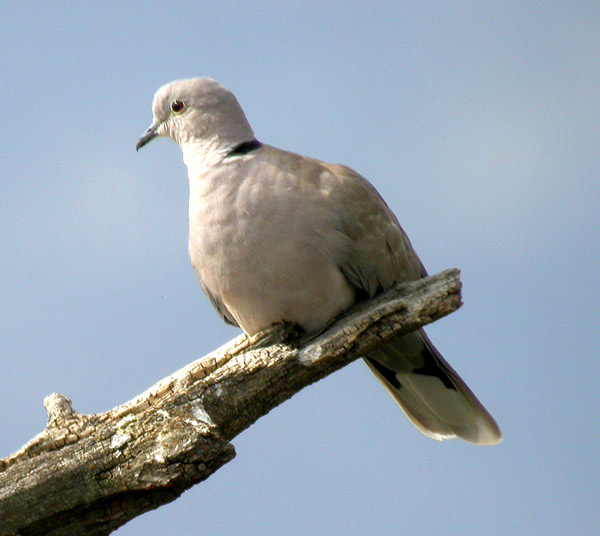 |
|
photo by Milt Moody |
Eurasian Collard-Dove
Bubulcus ibis
by Tuula Rose
[Rerun article from September 2007]
If prizes were given in the bird world for taking over continents, the Eurasian
Collared-Dove would win the “Expansionist Award”, beating the starling, the
English sparrow and even the cattle egret wings down. A hundred years ago this
species was found mainly on the Indian subcontinent with its range extending
slightly into Europe in Turkey. In the early 1900s it started expanding its
range into Europe reaching the British Isles by 1950. Today they are found above
the Arctic Circle in Scandinavia. According to my Finnish bird guide they
arrived in 1955 and now there are several hundred nesting there even reaching
the far north. Interestingly, the Finns call this bird the Turkish Dove.
On this continent, the saga is even more amazing. Eurasian Collared-Doves were
introduced (for whatever reason!) into the Bahamas in the 1970s and they soon
spread out on the islands. What happened next is unclear. Somehow they migrated,
without assistance, from the Bahamas to Florida, where they started expanding
unnoticed because they resemble the Ringed Turtle-Dove. In the mid-1980s
ornithologists realized that the suddenly prolific and quickly spreading “turtle
doves” they were watching were actually Eurasian Collared-Doves.
The Ringed Turtle-Dove has been a popular cage bird and escapees have
established small populations in Florida, California and a few other southern
states. These two doves look very much alike. They are uniformly pale brown, and
both have a black collar on the back of the neck. The RTD is smaller and has a
white belly and undertail coverts, while the ECD shows a darker grayer belly and
undertail, also showing more black at the base of the tail. Their songs are
quite different. The collared-dove’s song is a coarse rapidly delivered
three-part cooing while the turtle dove has a hollow rolling two-part song.
Since neither of these doves migrates, there were no strays or accidentals to
watch for from Europe. Our popular field guides never even listed or showed
pictures of the Eurasian Collared-Dove before the eighties. The 1983 edition of
the National Geographic Field Guide mentions the ECD in passing when describing
the RTD. The first picture I found among my field guides is in the 1997 edition
of All the Birds of North America. Even the 1990 3rd edition of Peterson Field
Guide does not have a picture.
The very first report of ECD in Utah was by Rob Fergus and Matt DeVries in Orem
in the summer of 1997. In 2000 this dove was seen at Fish Springs, of all
places, and an official sight report to the Records Committee was made by Taylor
Hicks. In September of 2001 Dana Green and others from Salt Lake were at River
Lane by Utah Lake and identified a Eurasian Collared-Dove. Several doves were
seen around a farm house at River Lane during that and the following year. They
were thought to be domesticated doves after someone asked the farmer who claimed
them to be his doves! Only after several reports came in from all around the
state did we realize that the ECD was indeed a wild bird taking over our state
and the entire continent. Experts are saying that only time will tell how the
spread of this non-native species is going to effect the populations of native
doves and pigeons. They also fear that it might become a pest for seed crops. It
is interesting to see this amazing spread on maps generated by The Great
Backyard Bird Count. Go to http://www.birdsource.org/gbbc/ and select: Explore
the results and Maproom to
see the maps for several years and the multi-year animation.
Both sexes of the Eurasian Collared-Dove are similar. They are usually solitary
or in pairs. The nest is made of twigs, stems, roots and grasses, and placed in
trees. The clutch is two white slightly glossy eggs. A pair can raise several
broods in a breeding season.
Interesting facts about pigeons and doves in general:
1. Since they eat mainly dry seeds and grains, their need for water is greater
than that of birds who feed on insects, worms, grubs or fruit. They drink up to
15% of their body weight per day. Unlike any other North American birds, they
are able to suction water into the throat without raising the head. Other birds
have to scoop water into the bill and tip the head up to let water run down the
throat.
2. Both the female and the male are able to produce a substance called “Pigeon
milk” or “Crop milk”. It is secreted by the lining of the crop and fed to chicks
for 5 to 10 days after hatching before being fed on regurgitated seeds. Rich in
fats and proteins, the crop milk meets the nutritional needs of young chicks in
the same way that insects and animal protein sustain the young of most other
bird species.
References:
-Articles on www.Birdsource.org by John Schmitt and Wesley M. Hochachka.
-The Sibley Guide to Bird Life and Behavior by David Allen Sibley.
-Rare Bird Sightings – Comprehensive List on www.utahbirds.org
If you would like to
write an article for the Bird of the Month, please contact
Eric Huish -
erichuish@gmail.com
Click here for past 'Birds of the Month'.
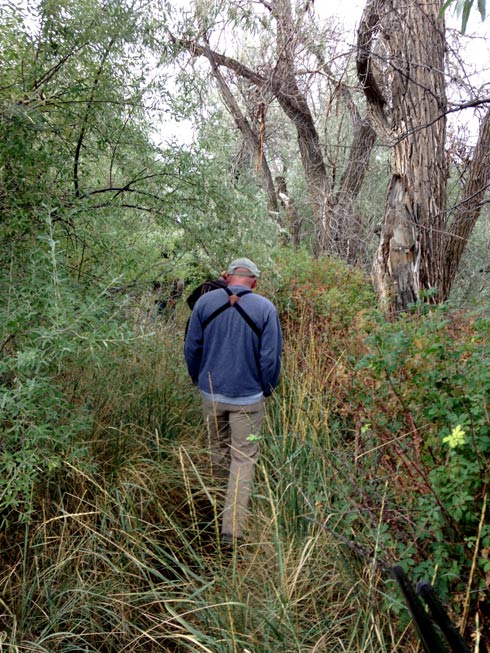 |
|
Our leader leading us down a wooded trail at Burraston Ponds Photo by Eric Huish |
Field Trip Report
Burraston Ponds - 14 September 2013
by Eric Huish
Six
Utah County Birders met on a nice Saturday Morning for a trip to Burraston Ponds
(Juab County) led by Bryan Shirley. We saw several birds at Burraston Ponds. My
favorite were two Soras out in the open giving us great views and a fly-over
Peregrine Falcon. Full list below.
On our way back we made short stops at Mona Reservoir, Goshen Canyon, and Warm
Springs WMA. Mona Res had lots of Canada Geese and a raft of Ruddy Ducks but was
otherwise pretty dead. Goshen Canyon was slow too. Best sighting there was a
couple of Golden Eagles. At Warm Springs our most interesting bird was a Juniper
Titmouse that seemed out of place without any junipers around.
More info on Burraston Ponds -
http://www.utahbirds.org/counties/juab/BurrastonPonds.htm
Info on birding Warm Springs -
http://www.utahbirds.org/counties/utahco/WarmSprings.htm
---------------------------------------
Burraston Ponds, Juab, US-UT
Sep 14, 2013 7:34 AM - 10:04 AM
Protocol: Traveling
1.2 mile(s)
Comments: UCB Field Trip. We walked along several trails in the area.
37 species (+6 other taxa)
California Quail 1 Heard Only
Ring-necked Pheasant 1 Heard Only
Pied-billed Grebe 1
Great Blue Heron 6
Sora 2
Caspian Tern 2
Mourning Dove 5
Belted Kingfisher 1
Northern Flicker 1 Heard Only
Peregrine Falcon 1 Flew over. Turned around and flew back over just to give us
all a good look!
Western Wood-Pewee 2
solitary vireo sp. 1
Warbling Vireo 1
Black-billed Magpie 1 Heard Only
Common Raven 2
Bank Swallow 50
Barn Swallow 1
swallow sp. 200
Marsh Wren 2 Heard Only
American Robin 17
Gray Catbird 1
European Starling 5
Cedar Waxwing 2
Orange-crowned Warbler 4
Nashville Warbler 1
Yellow Warbler 2
Yellow-rumped Warbler 5
Yellow-rumped Warbler (Audubon's) 10
Wilson's Warbler 2
warbler sp. 3 Yellowish warblers. Didn't get good look.
Green-tailed Towhee 1
Chipping Sparrow 2
Brewer's Sparrow 1
Spizella sp. 4 Brewer's/Chipping.
Song Sparrow 1
Lincoln's Sparrow 1
Western Tanager 2
Lazuli Bunting 1
Red-winged Blackbird 5
Western Meadowlark 8
blackbird sp. 20
House Finch 1
American Goldfinch 1 Heard Only
-----------------------------------------------------
Mona Reservoir - Juab Co. UT, Juab, US-UT
Sep 14, 2013 10:20 AM - 10:28 AM
Protocol: Stationary
Comments: UCB Field Trip. Stationary count overlooking the reservoir from the
parking area by the dam.
7 species (+3 other taxa)
Canada Goose 460
Ruddy Duck 30
Clark's Grebe 2
Western/Clark's Grebe 1
American White Pelican 7
Great Blue Heron 3
Larus sp. 1
Caspian Tern 1
Barn Swallow 8
sparrow sp. 1
---------------------------------------------
Warm Springs WMA - Utah Co. UT, Utah, US-UT
Sep 14, 2013 11:06 AM - 11:45 AM
Protocol: Traveling
0.9 mile(s)
Comments: UCB Field Trip.
10 species
Virginia Rail 1 Heard Only
Sandhill Crane 2 Heard Only
Black-billed Magpie 1
Barn Swallow 2
Juniper Titmouse 1 We were surprised to see one in this habitat.
Marsh Wren 1 Heard Only
American Robin 10
Orange-crowned Warbler 1
Western Tanager 2
House Finch 8
Field Trip Report
Squaw Peak Road and Overlook - 21 September 2013
by Eric Huish
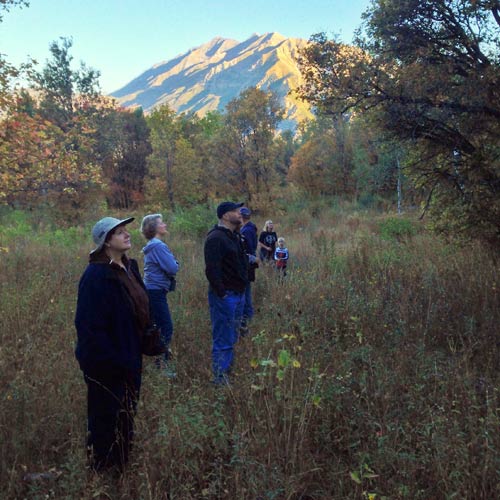 |
|
UCB birding Squaw Peak Road |
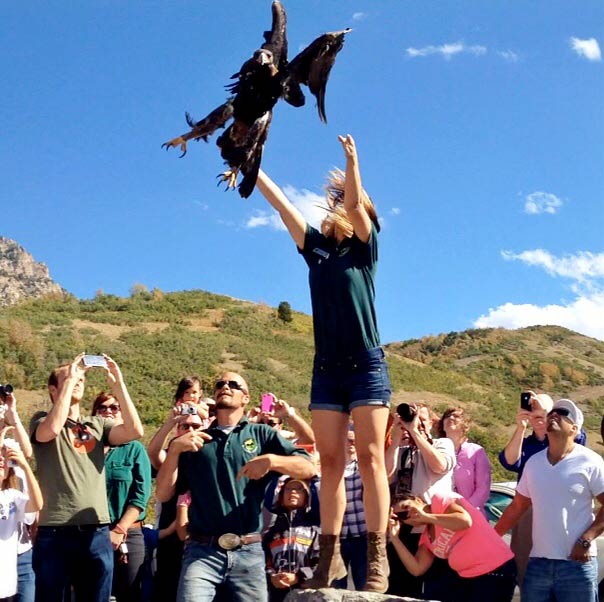 |
|
Rehabilitated Golden
Eagle being released at Squaw Peak Overlook |
This morning 10 Utah County Birders met and birded
along Squaw Peak Road then stopped at the Squaw Peak Overlook parking lot to
hawkwatch with the DWR's Watchable Wildlife "Raptor Watch Day". Birds were
scarce along Squaw Peak Road in the morning. Best birds were Cassin's Vireo and
a few Clark's Nutcrackers. Full list below.
Hawkwatching at the overlook was fun. It was very windy. Hawk numbers weren't
huge but we did get to see several hawks and we got great close views of most of
them. In the afternoon some rehabilitated raptors were released - a Golden
Eagle, 2 Swainson's Hawks and a Great Horned Owl. I left early so the list below
isn't the full list -
More info on Squaw Peak Road -
http://www.utahbirds.org/counties/utahco/SquawPeakTrail.htm
---------------------------
Squaw Peak Rd, Utah, US-UT
Sep 21, 2013 8:30 AM - 10:37 AM
Protocol: Traveling
5.1 mile(s)
Comments: UCB Field Trip. We birded along Squaw Peak Road above were the paved
section ends. Birds seen hawkwatching at the overlook were entered on a separate
list.
10 species (+2 other taxa)
Red-tailed Hawk 3
Northern Flicker 2 Heard Only
diurnal raptor sp. 1 Golden Eagle???
Cassin's Vireo 1
Steller's Jay 2
Clark's Nutcracker 4
Black-capped Chickadee 5
Ruby-crowned Kinglet 1
Yellow-rumped Warbler 2
White-crowned Sparrow 1
Dark-eyed Junco (Gray-headed) 2
sparrow sp. 2
---------------------------------
Squaw Peak Overlook, Utah, US-UT
Sep 21, 2013 10:38 AM - 2:05 PM
Protocol: Stationary
Comments: Hawkwatching. Stationary count at Squaw Peak Overlook parking lot. DWR
Watchable Wildlife Event.
12 species (+1 other taxa)
Turkey Vulture 1
Golden Eagle 4
Sharp-shinned Hawk 5
Cooper's Hawk 7
Accipiter sp. 9
Red-tailed Hawk 10
White-throated Swift 6
American Kestrel 3
Steller's Jay 4
Western Scrub-Jay 1
Black-billed Magpie 2
Barn Swallow 8
Spotted Towhee 1
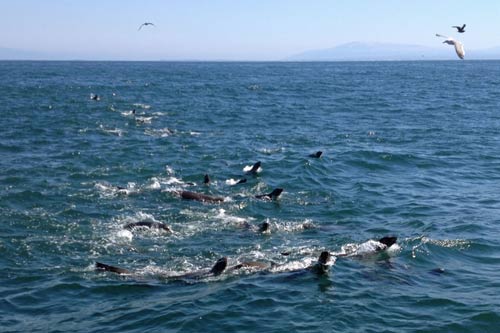 |
|
Sea lions on pelagic trip |
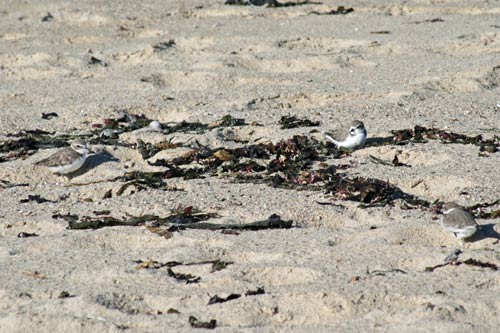 |
|
Snowy Plover on Carmel
Beach |
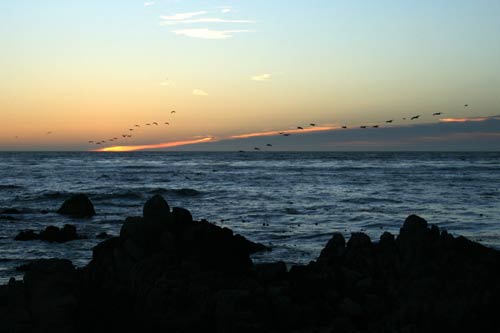 |
|
Sunset and Brown Pelicans
at Point Pinos |
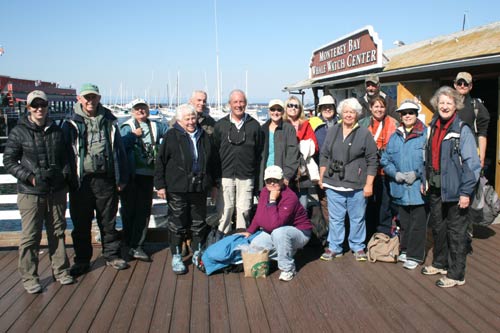 |
|
Utah County Birders Pelagic
Trip Group with our trip leader Debi Shearwater front and center |
Field Trip Report
Monterey, California - 25-29 September 2013
By Keeli Marvel
Thirteen bird watchers met over the course of five days for birding in the
Monterey area of California. The focus of the trip was a Shearwater Journeys
Pelagic trip traveling out of Monterey Bay, however, various members of the
group were able to bird the days around the trip as well.
On Thursday, several members of our group met up and traveled north from
Monterey to the area of Moss Landing to spend the day there birding. Our first
stop was Moon Glow Dairy where our target bird, Tricolored Blackbird, was
quickly attained. After stopping just inside the front gate to scope out the
flocks of blackbirds and to nab our target bird, we continued along the road to
an overlook that looks down on Elkhorn Slough. There our highlight birds were a
multitude of shorebirds, terns, basking sea lions, a White-tailed Kite,
Red-shouldered Hawk, Red-necked Phalarope, Pelagic Cormorant, Anna’s
Hummingbird, and an up-close view of a Red-winged Blackbird next to a Tricolored
Blackbird for a good comparison. Moon Glow Dairy is privately owned but
generously kept open to the birdwatching community. For more information on how
to get there and etiquette for birding the Dairy, please go to the following
website:
http://creagrus.home.montereybay.com/moonglow.html
Our next stop was Elkhorn Slough National Estuarine Research Reserve. There we
hiked around a 2.4 mile trail that went through a diverse range of habitats
including dry oak forests, Eucalyptus groves, and estuary/slough mudflats. Our
highlight birds included multiple Acorn Woodpeckers in a granary (bunch of trees
full of holes where the woodpeckers stash food), a pair of Wrentits, California
Towhee, California Thrasher, Townsend’s Warbler, Pacific-slope Flycatcher,
Chestnut-backed Chickadees in the Eucalyptus grove, and several species of
shorebirds in the slough. We also saw Bat rays swimming around in the water of
the slough.
We spent the rest of the afternoon birding around Moss Landing Wildlife Area and
north jetty where we saw a Brandt’s Cormorant, mixed flocks of Marbled Godwits
and Willets, Heerman’s Gulls, hundreds of Elegant Terns perched on the jetties,
more Sea Lions, and a small group of Sea Otters grooming, snoozing, and playing
in the harbor. We finished the day off with a quick trip back to Monterey where
we drove through Pacific Grove out to Point Pinos. There along the coast we
found a few Black Oystercatchers, Black Turnstones, a Snowy Egret balancing on a
kelp bed riding the waves of the surf, and a steady stream of Brown Pelican,
Cormorants, and other far off birds flying around the point.
Friday was the major event of the entire trip- a pelagic trip with Debbie
Shearwater and Shearwater Journeys. Despite some sea sickness in the group (it
can happen to anyone!) we were able to get some good birds and some great views
of Humpback whales, Risso’s and Pacific White-sided dolphins, Dall’s Porpoise,
Sunfish, Sea Nettle (jellyfish) and a strange sighting of what possibly was a
self-propelled autonomous research drone cruising around in the ocean. Our
highlight birds of the trip (some with better looks than others) included Common
Murre, five species of shearwater (Pink-footed, Flesh-footed, Sooty, Bullers,
and Manx), Tufted Puffin, Black-footed Albatross, Rhinoceros Auklet, Surfbirds
on the jetty, Pigeon Guillemot, Pomarine and Parasitic Jaegers, South Polar Skua,
and Surf Scoters. At one point we located a huge feeding aggregation of whales,
sea lions, and birds that Debi said were probably feeding on huge schools of
anchovies, sardines, and possibly squid. Pretty cool!
Saturday we finished our trip to Monterey by meeting up with the Monterey
Audubon Society for a field trip around Carmel River Lagoon. We birded around
the beach for an hour or so where we located a Whimbrel along the shore, and at
least fifteen Snowy Plover hunkered down in the sand. From there, we hiked up
the brush along the shore where a few of the group got looks at a Golden-crowned
Sparrow. From there we continued up a trail looking down over the Carmel River
and into the oak forest where highlights included another pair of Wrentits, a
pair of White-tailed Kites perched in the distance, Chestnut -backed Chickadees,
Bushtits, Oak Titmouse, Townsend’s and Orange-crowned Warblers, California
Towhee, and another Pacific-slope Flycatcher. It was a great trip led by some
really friendly local birders!
After the field trip, the group split up to chase various species. Doug went
down the coast where he got to see a California Condor cruising along the
coastline. The rest of the group ventured inland into the upper Carmel Valley in
search of Yellow-billed Magpies. We struck out on the Magpies, but not without a
fair bit of effort. We did see a few good birds, including Western Bluebirds,
more Acorn Woodpeckers, a Gray Catbird, Brown Creeper, California Towhee, and
Oak Titmouse. The highlight for me was a sighting of two Bobcats, and on the way
back, a Tarantula walking down the middle of the road. The first Bobcat we
spotted wasn’t too far off the road and we got to watch it hunt and catch its
dinner (a ground squirrel or prairie dog of some kind), so that was pretty neat.
Overall I’d say we had a pretty successful trip. Everyone in our group went home
with several life birds, and we really enjoyed our short time we spent in
Monterey and the surrounding areas. I also enjoyed getting to know the birders
in our group better as we traveled to and from Monterey and spent a couple of
days birding together. Thanks everyone for a great trip!
September 2013
Lyle Bingham - Payson
Western wood pewee - It stayed all afternoon, flying from its perch to catch an insect, and back to the perch in the snag.
Jeff Cooper - Pleasant Grove
Western Screech-Owl - Yard bird #72!
-
http://neovistabirding.blogspot.com/2013/09/yard-bird-72-owl-serendipity.html
Eric Huish - Pleasant Grove
Wilson's Warbler - a bright male visited the yard.
Milt Moody - Provo
After a summer break the Lesser Goldfinches and a Spotted Towhee
or two are coming back to my yard.
Report your favorite backyard
bird each month to Eric Huish at 801-360-8777 or erichuish@gmail.com
Newsletter Announcement. The Utah County Birders Newsletter is now online only.
We've decided to stop the regular paper mail version of the UCB Newsletter. This will save our club on Printing, Postage and Paper. If you would like an email notice each month when the Newsletter is posted online please send an email to Eric Huish at erichuish@gmail.com or subscribe to the ucbnet mailing list. To subscribe to ucbnet just send an e-mail to ucbnet-subscribe@utahbirds.org
We are willing to print the online version of the newsletter and mail it out to anyone who still wants a paper copy or who doesn't have internet access. If you know of anyone who enjoys the UCB Newsletter but doesn't have internet access please let Eric Huish or Keeli Marvel know and we will make sure they get a copy.